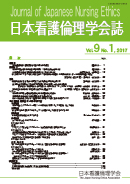Volume 9, Issue 1
Displaying 1-23 of 23 articles from this issue
- |<
- <
- 1
- >
- >|
Editorial
-
2017Volume 9Issue 1 Pages 1-2
Published: March 20, 2017
Released on J-STAGE: May 31, 2019
Download PDF (244K)
Original Articles
-
2017Volume 9Issue 1 Pages 3-11
Published: March 20, 2017
Released on J-STAGE: May 31, 2019
Download PDF (544K) -
2017Volume 9Issue 1 Pages 12-21
Published: March 20, 2017
Released on J-STAGE: May 31, 2019
Download PDF (581K) -
2017Volume 9Issue 1 Pages 22-30
Published: March 20, 2017
Released on J-STAGE: May 31, 2019
Download PDF (500K)
Notes
-
2017Volume 9Issue 1 Pages 31-37
Published: March 20, 2017
Released on J-STAGE: May 31, 2019
Download PDF (885K) -
2017Volume 9Issue 1 Pages 38-44
Published: March 20, 2017
Released on J-STAGE: May 31, 2019
Download PDF (513K) -
2017Volume 9Issue 1 Pages 45-52
Published: March 20, 2017
Released on J-STAGE: May 31, 2019
Download PDF (455K)
Letters
-
2017Volume 9Issue 1 Pages 53-56
Published: March 20, 2017
Released on J-STAGE: May 31, 2019
Download PDF (309K) -
The meaning and value of posting manuscripts as your phronesis in Journal of Japanese Nursing Ethics2017Volume 9Issue 1 Pages 57-60
Published: March 20, 2017
Released on J-STAGE: May 31, 2019
Download PDF (319K) -
2017Volume 9Issue 1 Pages 61-63
Published: March 20, 2017
Released on J-STAGE: May 31, 2019
Download PDF (284K)
9th Annual Conference of Japan Nursing Ethics Association
President’s address
-
2017Volume 9Issue 1 Pages 64-65
Published: March 20, 2017
Released on J-STAGE: May 31, 2019
Download PDF (244K)
Keynote address
-
2017Volume 9Issue 1 Pages 66
Published: March 20, 2017
Released on J-STAGE: May 31, 2019
Download PDF (131K)
Overseas invited lecture
-
2017Volume 9Issue 1 Pages 67-78
Published: March 20, 2017
Released on J-STAGE: May 31, 2019
Download PDF (513K)
Educational lecture
-
2017Volume 9Issue 1 Pages 79-80
Published: March 20, 2017
Released on J-STAGE: May 31, 2019
Download PDF (211K)
Symposium I
-
2017Volume 9Issue 1 Pages 81
Published: March 20, 2017
Released on J-STAGE: May 31, 2019
Download PDF (269K) -
2017Volume 9Issue 1 Pages 81-82
Published: March 20, 2017
Released on J-STAGE: May 31, 2019
Download PDF (320K) -
2017Volume 9Issue 1 Pages 82
Published: March 20, 2017
Released on J-STAGE: May 31, 2019
Download PDF (294K) -
2017Volume 9Issue 1 Pages 83
Published: March 20, 2017
Released on J-STAGE: May 31, 2019
Download PDF (234K)
Symposium II
-
2017Volume 9Issue 1 Pages 84
Published: March 20, 2017
Released on J-STAGE: May 31, 2019
Download PDF (286K) -
2017Volume 9Issue 1 Pages 84-85
Published: March 20, 2017
Released on J-STAGE: May 31, 2019
Download PDF (290K) -
2017Volume 9Issue 1 Pages 85
Published: March 20, 2017
Released on J-STAGE: May 31, 2019
Download PDF (246K) -
2017Volume 9Issue 1 Pages 85-86
Published: March 20, 2017
Released on J-STAGE: May 31, 2019
Download PDF (250K) -
2017Volume 9Issue 1 Pages 86
Published: March 20, 2017
Released on J-STAGE: May 31, 2019
Download PDF (229K)
- |<
- <
- 1
- >
- >|
